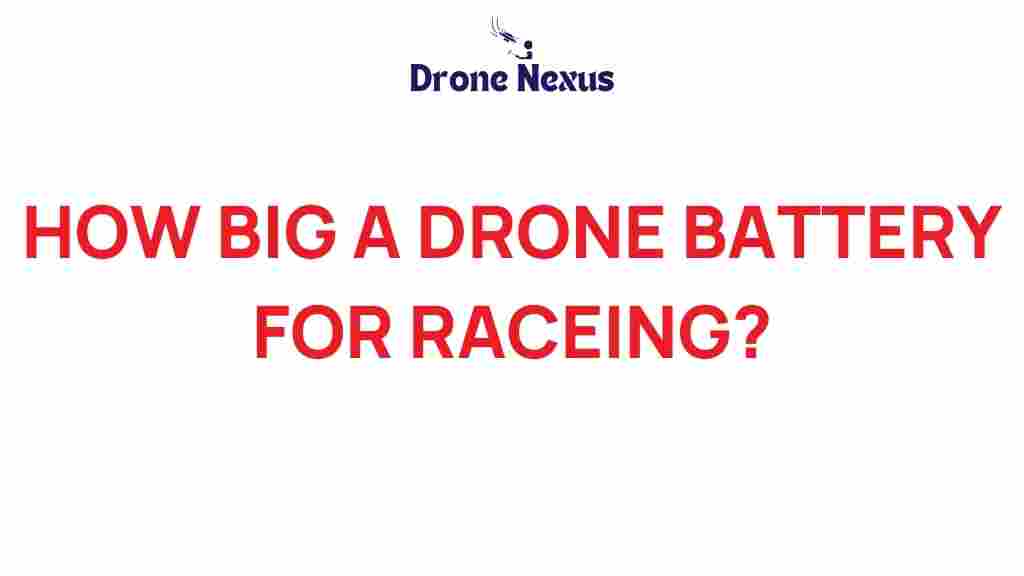How Big Should a Drone Battery Be for Optimal Racing Performance?
Drone racing is an exhilarating sport, combining speed, agility, and precision. One of the most critical factors that can influence a drone’s performance is its battery. Selecting the right drone battery can mean the difference between winning and losing a race. In this article, we will explore the various aspects of drone batteries, their sizes, and how they impact racing performance. Whether you’re a seasoned racer or a beginner, understanding battery specifications will enhance your racing experience.
Understanding Drone Battery Basics
Before delving into the specifics of size and capacity, it’s essential to understand the basics of drone batteries. Most racing drones utilize lithium polymer (LiPo) batteries due to their lightweight and high energy density. Here are a few key terms related to drone batteries:
- Voltage (V): Determines the power output of the battery.
- Capacity (mAh): Indicates how much energy the battery can store. Higher mAh means longer flight time.
- C-Rating: Reflects the discharge rate of the battery; a higher C-rating allows for more power output.
Choosing the Right Size Drone Battery
Choosing the right size for your drone battery involves understanding your drone’s specifications and racing needs. Here are some considerations to keep in mind:
- Drone Weight: Heavier drones require larger batteries to maintain performance. However, a larger battery also adds weight, which can impact speed.
- Flight Time: If you’re planning longer races, a larger capacity battery will provide extended flight times but may add weight.
- Motor Specs: Check the specifications of your drone’s motors. They may require specific voltages that dictate the required battery size.
Common Battery Sizes for Racing Drones
Most racing drones use battery sizes measured in cells (usually 3S, 4S, or 6S). Here’s a quick overview:
- 3S (11.1V): Ideal for lighter drones; provides a balance between speed and flight time.
- 4S (14.8V): Commonly used in most racing drones; offers a good mix of power and efficiency.
- 6S (22.2V): Best for high-performance racing drones; delivers maximum power but with increased weight.
Calculating the Optimal Battery Capacity
To determine the optimal capacity for your drone battery, consider the following steps:
Step 1: Determine Your Drone’s Power Requirements
Check the specifications of your drone’s motors and ESCs (electronic speed controllers). Look for the recommended voltage and current ratings. This will give you a baseline for battery selection.
Step 2: Estimate Flight Time
Flight time can be estimated by calculating the power consumption of your drone. A general rule of thumb is:
- Flight Time (minutes) = (Battery Capacity (mAh) / Average Current Draw (mA)) x 60
For example, if your drone has a 1300 mAh battery and an average current draw of 20A (20000 mA), the estimated flight time would be:
- Flight Time = (1300 / 20000) x 60 ≈ 3.9 minutes
Step 3: Balance Weight and Performance
While larger batteries offer longer flight times, they can also add unnecessary weight. Aim for a battery that provides enough capacity without compromising speed. A good practice is to keep your drone’s weight within the recommended limits for optimal performance.
Battery Maintenance Tips for Racing Performance
Proper maintenance of your drone battery can significantly enhance its performance and lifespan. Here are some tips:
- Storage: Store your LiPo batteries at around 3.7V per cell to prevent damage.
- Charging: Use a high-quality charger specifically designed for LiPo batteries. Avoid overcharging and monitor the charging process.
- Inspection: Regularly check your batteries for any signs of swelling or damage. Dispose of damaged batteries properly.
Troubleshooting Common Battery Issues
Even with proper care, you may encounter issues with your drone battery. Here are some common problems and their solutions:
Issue 1: Short Flight Time
If you notice shorter flight times, it may be due to:
- Worn-out battery: Consider replacing it if it’s more than 50 cycles old.
- Incorrect settings: Ensure your drone’s settings are optimized for flight.
Issue 2: Battery Overheating
Overheating can be dangerous. Here’s how to resolve it:
- Check C-rating: Make sure your battery is rated for the power your drone draws.
- Cooling down: Allow your battery to cool down before using it again.
Issue 3: Charging Problems
If your battery isn’t charging correctly, consider the following:
- Check connections: Ensure all connections are secure and not damaged.
- Inspect charger: Make sure your charger is functioning correctly.
Conclusion
Choosing the right drone battery is crucial for achieving optimal racing performance. By understanding battery specifications, calculating capacity, and maintaining your batteries, you can enhance your drone racing experience. Always consider your drone’s weight, power needs, and the type of races you plan to participate in. Remember, a well-maintained battery not only improves performance but also extends its lifespan.
For more tips on drone racing, check out our article on maximizing your drone’s speed. And for more information on battery technology, visit Battery University.
This article is in the category Technology and created by DroneNexus Team
